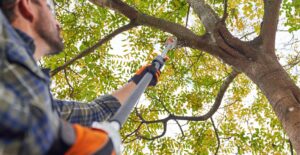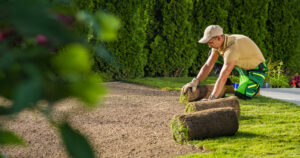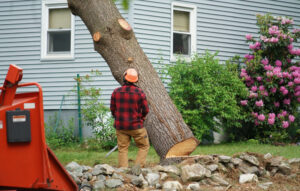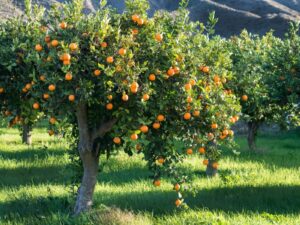Tree trimming is an essential part of maintaining a healthy, attractive, and safe yard. Well-maintained trees enhance property aesthetics, increase value, and reduce potential hazards like falling branches. This article will cover all aspects of residential tree trimming, including costs, service options, required equipment, techniques, safety protocols, and some useful tips to ensure a successful tree-trimming project.
1. Cost of Residential Tree Trimming
The cost of tree trimming depends on several factors, including tree size, location, and the complexity of the job. Here’s a general breakdown:
- Small Trees (up to 30 feet): $75 – $400
- Medium Trees (30-60 feet): $150 – $800
- Large Trees (60 feet and taller): $500 – $1,500 or more
Other factors influencing cost include:
- Tree Health: Diseased or damaged trees can increase labor.
- Accessibility: Trees close to power lines or buildings may require special equipment and extra precautions.
- Number of Trees: Discounts may apply for trimming multiple trees at once.
- Emergency Trimming: Costs are higher if you need immediate service due to storms or safety concerns.
Additional Costs:
- Stump Grinding: $100 – $400
- Debris Removal: $50 – $150
- Travel Fees: May apply if the service area is outside the contractor’s usual range.
To save on costs, consider scheduling tree trimming during the off-season (late winter) when demand is lower.
2. Tree Trimming Services
Professional tree trimming companies offer several services, depending on the tree’s needs:
- Crown Thinning: Reducing the tree’s crown to allow more light and air to pass through, which promotes growth and prevents wind damage.
- Crown Reduction: Reducing the size of the tree’s overall structure. Useful for preventing the tree from interfering with buildings or power lines.
- Deadwood Removal: Cutting off dead or diseased branches to improve the tree’s health and safety.
- Canopy Raising: Removing lower branches to raise the tree’s canopy, which improves clearance for pedestrians or vehicles.
- Pruning for Shape: Maintaining the aesthetic appearance of ornamental trees through strategic trimming.
Always ensure that your service provider is certified (such as by the International Society of Arboriculture, ISA) to guarantee quality work and safe practices.
3. Equipment Used in Tree Trimming
Proper equipment is crucial for effective and safe tree trimming. Some common tools include:
- Hand Pruners: For cutting smaller branches and twigs.
- Loppers: Larger pruners used to cut thicker branches, up to 2 inches in diameter.
- Pole Pruners: For trimming branches high above ground without the need for a ladder.
- Chainsaws: For cutting large branches or limbs. Useful for mature trees.
- Rope and Harness: For safely climbing trees and securing large branches during cutting.
- Ladders: An extendable ladder is often used for medium-height tree trimming.
- Wood Chipper: To reduce the trimmed branches into mulch or chips, which can be reused in landscaping.
Professionals may also use bucket trucks for reaching tall trees or difficult-to-access areas.
4. Tree Trimming Techniques
Different techniques are applied based on the type of tree and the goal of the trimming:
- Crown Cleaning: This technique involves removing dead, diseased, or weak branches to improve the tree’s health and appearance.
- Crown Raising: This is used to increase clearance under the tree, particularly in urban areas.
- Crown Reduction: This method is employed to reduce the height or spread of a tree. It involves cutting the ends of branches back to smaller lateral branches.
- Directional Pruning: This is used to train a tree to grow in a particular direction or to prevent interference with nearby structures.
- Topping (Should be avoided): Removing the top of the tree, which can lead to weak regrowth and is generally harmful. This is usually considered a last-resort technique.
Read : Professional Tree Trimming Techniques
When to Trim:
- Dormant Season (Late Winter): Best time for most trees, as it reduces the risk of disease, promotes healing, and ensures minimal stress.
- Summer Pruning: Can be done to correct growth or improve tree shape.
5. Safety Protocols
Tree trimming can be dangerous, especially for larger trees or those located near power lines or buildings. Following strict safety guidelines is essential:
- Wear Safety Gear: Always wear protective equipment such as helmets, safety goggles, gloves, and sturdy boots. Chainsaw operators should use chaps to protect their legs.
- Secure Ladder: When using a ladder, ensure it is stable and positioned on solid ground. Use a rope or harness when climbing trees.
- Watch for Power Lines: Avoid trimming trees near power lines without the help of a professional.
- Teamwork: It’s always safer to have a partner, especially for large jobs. A second person can assist with branch removal and monitor for hazards.
- Mind the Weather: Avoid trimming during windy, rainy, or icy conditions, which can make branches slippery and reduce visibility.
6. Tips for Successful Tree Trimming
- Trim at the Right Time: Pruning at the correct time of year can make a significant difference in tree health and growth. Late winter or early spring is often best for most trees.
- Make Clean Cuts: Ensure cuts are clean and made at the correct angles to encourage proper healing. Jagged cuts can leave the tree susceptible to disease.
- Don’t Over-Prune: Removing more than 25% of a tree’s foliage in one year can stress the tree and hinder its growth.
- Know Your Trees: Different species have different pruning needs. For instance, fruit trees may require more frequent pruning to encourage fruit production, while evergreens need minimal trimming.
- Use the Right Tools: Always use sharp, well-maintained tools to avoid damage to the tree. Dull blades can crush branches instead of cleanly cutting them.
- Consider Mulching: After trimming, consider using the cut branches for mulch. This will not only recycle the material but also help conserve moisture around the base of the tree.
Residential tree trimming is an investment in the health, safety, and beauty of your property. Whether you’re tackling a small tree on your own or calling in the professionals for a larger project, understanding the costs, services, equipment, and safety practices can ensure that your trees thrive for years to come. Remember, it’s always wise to consult a professional arborist for complex or risky jobs to avoid injury and protect your trees.
FAQs About Residential Tree Trimming
- How often should trees be trimmed?
Most trees should be trimmed every 3-5 years, depending on their size, type, and growth rate. Young trees may require more frequent trimming to shape their structure, while mature trees need less frequent maintenance unless they pose safety hazards. - What is the best time of year to trim trees?
The best time to trim trees is during late winter when they are dormant. This minimizes stress, encourages healthy regrowth, and reduces the risk of spreading disease. Summer pruning can also be done for specific issues like shape correction or hazard reduction. - How much does it cost to trim a large tree?
Trimming a large tree (over 60 feet) typically costs between $500 and $1,500. The final cost depends on factors like tree condition, location, and whether specialized equipment is needed. Emergency trimming services may also incur additional charges. - Can I trim my own trees?
Yes, you can trim small trees yourself with the right tools. However, for large trees, trees near power lines, or complex trimming tasks, hiring a professional is safer and more effective. Improper trimming can harm the tree or lead to personal injury. - What equipment do professionals use for tree trimming?
Professionals use hand pruners, loppers, pole saws, chainsaws, climbing harnesses, ropes, and bucket trucks for higher or hard-to-reach branches. They also use wood chippers for debris disposal. These tools ensure precision and safety during tree trimming. - Will trimming damage my tree?
When done correctly, trimming promotes tree health by removing dead or diseased branches. However, improper trimming, such as cutting too much or making jagged cuts, can harm the tree and increase the risk of disease or decay. - What is the difference between pruning and trimming?
Trimming focuses on improving the tree’s appearance and reducing hazards by cutting branches. Pruning, on the other hand, involves removing dead or diseased branches and managing growth to maintain tree health and structure, often with a more technical approach. - How do I know if my tree needs trimming?
Signs include dead or broken branches, overgrowth, limbs interfering with structures or power lines, and uneven growth patterns. Regular visual checks for these issues will help you determine when your tree needs attention from a professional. - Can trimming help a diseased tree?
Yes, trimming can remove diseased branches and help stop the spread of infections. However, a professional arborist should assess the tree to determine if additional treatments are needed, as trimming alone may not always be enough. - Is tree trimming necessary after a storm?
Yes, after a storm, it’s essential to inspect trees for broken or dangling branches that can pose safety hazards. Trimming damaged branches promptly will prevent further damage to the tree and nearby property. - How can I save money on tree trimming?
To save money, consider trimming multiple trees at once, schedule during the off-season, and maintain regular care to prevent the need for costly emergency services. Always get quotes from multiple providers for competitive pricing. - What safety measures should be taken during tree trimming?
Always wear protective gear, secure ladders, and use ropes or harnesses when climbing. Avoid trimming near power lines unless you’re a trained professional, and never work during inclement weather that may compromise safety. - How long does tree trimming take?
The time required depends on the tree’s size and the complexity of the job. Small trees can take a couple of hours, while larger trees may take a full day. Emergency or complex jobs may extend beyond a single day. - What happens to the branches after trimming?
Most professional tree services offer debris removal or wood chipping services. You can also keep the trimmings for firewood or mulch if desired. Always confirm disposal options and any associated costs before hiring. - Is a permit required for tree trimming?
In some areas, permits are required, especially for large trees or trees protected by local ordinances. Check with your municipality or HOA to determine if a permit is needed before trimming. Professionals are usually familiar with local regulations.





